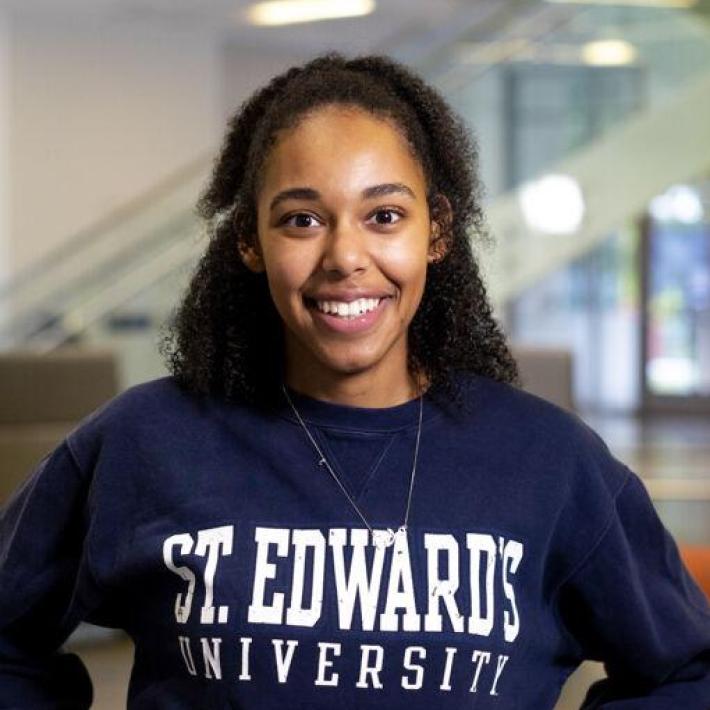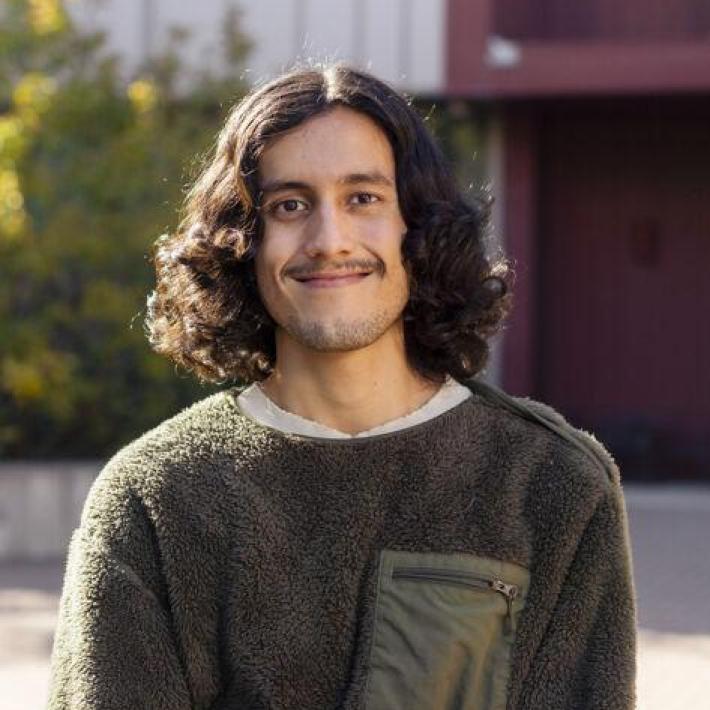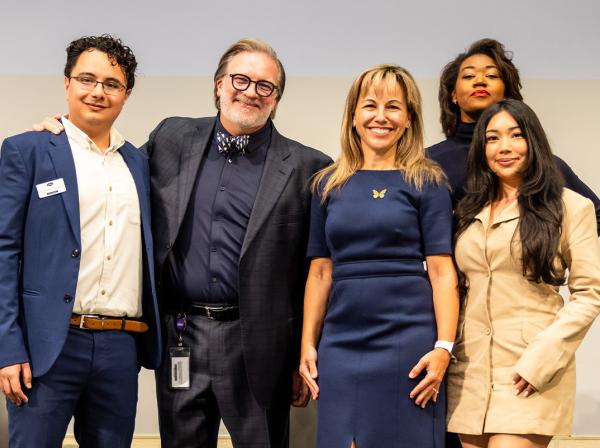Becoming Changemakers
Meriam Elawad and Eduardo “Lalo” Carrillo chose St. Edward’s for its rigorous academics and emphasis on service and justice. They came to college hoping to change the world for the better and, through internships and research, they discovered how to connect their passion with a career. Experiential learning helped them find their calling — and earn St. Edward’s highest honor, a Presidential Award.
Growing up, Meriam Elawad had always been concerned about the environment. She hoped that college would help her find a career aimed at protecting the natural world. “I knew that I wanted to make a difference, but I didn’t know how to go about doing that,” she remembers.
At St. Edward’s, a course called Environmental Controversies in Austin gave her a roadmap. Each week, local guest speakers explained how they were helping people gain access to fresh produce, working to prevent urban sprawl, and combating air and water pollution. Elawad realized that justice for the environment and justice for people went hand in hand.
“Having people from Austin come into our classroom and talk about these issues really opened my eyes,” she says. “That class solidified for me that social justice was a big aspect of environmentalism.”
She decided that shaping policy, including laws and budgets around housing, urban planning and pollution, was the key to creating positive change. To learn more about how and why people get involved with their government, she pursued an internship with MOVE Texas. The nonpartisan organization helps underrepresented communities participate in their democracy, and part of Elawad’s job was helping people register to vote. To Elawad, the importance of voting was clear — but when she asked people why they had never voted, she was surprised by their answers. Some didn’t know where to send their voter registration form. Others didn’t get off work until polling places closed. Still others thought voting wouldn’t make a difference.

“Learning about those reasons, and the problems in our current model that hinder people from voting, gave me so many ideas for how to solve those problems.”
My assumptions about why people didn’t go out and vote were not always accurate,” she says. “Learning about those reasons, and the problems in our current model that hinder people from voting, gave me so many ideas for how to solve those problems.” Elawad decided to double major in Political Science and Environmental Science and Policy. This would help her understand the inner workings of government, as well as the science behind environmental policies.
“Learning about those reasons, and the problems in our current model that hinder people from voting, gave me so many ideas for how to solve those problems.”
Over the summer, she got hands-on experience with scientific research designed to inform a local environmental policy. Elawad’s advisor, Associate Professor of Environmental Science Amy Concilio, was helping the city of Austin develop its climate equity plan, which included becoming carbon neutral by 2040. Concilio wanted to understand whether restoration of native Hill Country grasses would increase carbon storage, so the city could encourage landowners to plant those grasses. To find out, Elawad and her research partner measured carbon in soil samples from native- and invasive-dominated grasslands at Commons Ford Ranch Metropolitan Park, Wild Basin Creative Research Center and Spicewood Ranch, preserves in the Austin area where St. Edward’s students regularly conduct research.
Elawad also helped write policy herself as an intern with the Texas Commission on Environmental Quality through the commission’s Mickey Leland Environmental Internship Program.
During her Leland internship, Elawad served on a special taskforce reviewing the impact of 2021’s devastating Winter Storm Uri. Elawad met with representatives of water utilities to learn why their systems had failed during the freeze and researched winterization strategies used in other states. She was elated to learn that one of the policies she suggested Texas adopt was included in the agency’s final report presented to the governor.
Elawad’s next step is earning a degree from Vermont Law School, one of the top environmental law programs in the country. Its strong sense of community and mission-driven approach remind her of St. Edward’s. “They care about social justice, they care about the environment, and they want people who share those values,” she says.
Lalo Carrillo attended a health professions high school and chose St. Edward’s for its undergraduate research opportunities. He knew that if he wanted a career in science or medicine, he would need to understand how scientific research was conducted and be able to read articles in scientific journals.
“Everything we know about medicine has to come from research,” he explains. “And being a part of that behind-the-scenes work makes me feel like I’m making a difference.”
He jumped into research the summer after his freshman year, completing a short project with a professor who was studying soil microbiology. Later, he joined the lab of Professor of Biological Sciences Andrea Holgado, who is conducting molecular neuroscience research that may influence care for people who have Alzheimer’s.
Scientists who want to understand Alzheimer’s and develop potential treatments can’t study the brains of living patients. They have to experiment on other organisms that structurally resemble humans in some way. One such model organism is C. elegans, a tiny roundworm with 302 neurons and a genome that scientists have fully sequenced. Carrillo worked on a project that manipulated a protein called UNC-33 in C. elegans that is associated with neurodegenerative diseases like Alzheimer’s in humans. Studying UNC-33 in C. elegans can help scientists form ideas about disease development and treatment in people.
Passionate about majoring in Biology, Carrillo felt at home in the research lab, advancing the work of science to eventually help patients. “It’s fascinating to be at that front line of discovering something we don’t fully understand yet,” he says.
Carrillo also took a course with Dr. Holgado that shaped his current career path. In Neurobiology of Mental Illness, he learned about the molecular mechanism of disorders including depression and Alzheimer’s. One class session focused on the recent clinical trials of ketamine, a drug that can help patients with treatment-resistant depression and other mental health conditions by fostering regrowth of neurons and their connections in the brain, a phenomenon called neuroplasticity.
In the clinical trials, patients receive a ketamine infusion in the controlled environment of a clinic and, while in the dissociative state the drug induces, process memories of abuse or trauma that are difficult to deal with consciously. Combined with talk therapy, ketamine showed promise for patients whose depression had not responded to other medications.
Carrillo was intrigued. “You can learn about the science that has already been done, but it was really cool listening to my professor talk about the science that we’re doing right now,” he says. As Carrillo prepared to graduate, he applied to work at the Austin Ketamine Clinic, which offers ketamine infusions for mental health treatment. Carrillo now works at the clinic as an EMT-B, providing immediate care and monitoring patients’ vital signs to facilitate the safe, comfortable environment necessary for maximizing the therapeutic benefit of a psychedelic experience. The job integrates his academic training with real-world, hands-on experience. “It has been decades since the field of psychiatry has seen this much hope and promise,” he says. “Ketamine therapy is the launching point into a new frontier of psychedelic therapies for the treatment of mental health conditions.” Next year he will apply to medical school, where he’ll likely focus on psychiatry to become a medical doctor or conduct research to develop new treatments.

“Everything we know about medicine has to come from research,” he explains. “And being a part of that behind-the-scenes work makes me feel like I’m making a difference.”
St. Edward’s also helped Carrillo focus on the people he most wants to help. His sophomore year, he joined Ciencias Sin Fronteras, a Spanish-speaking science club in the School of Natural Sciences whose members discuss Hispanic scientists and their own experiences as Hispanic students in STEM. Club meetings were an opportunity for Carrillo to practice his Spanish and to reflect on his upbringing in the border town of Mission. He also realized, after hearing mental health discussed openly at St. Edward’s, that older generations in his family and Hispanic community were reluctant to talk about mental health or seek therapy.
He decided to focus his career on mental health within the Hispanic population. “I want to be like a bridge between psychiatry and therapy, and people like my parents and grandparents, because I think mental health is overlooked in our culture,” he says.
“Everything we know about medicine has to come from research,” he explains. “And being a part of that behind-the-scenes work makes me feel like I’m making a difference.”
Both Carrillo and Elawad came to St. Edward’s with specific interests, but they didn’t know how to turn those ideas into meaningful careers. Their classes, internships and research experiences helped them develop a plan and focus on making a difference. Their senior year, they were among 12 students recognized with Presidential Awards: the university’s top honor awarded to outstanding leaders, innovators and justice-minded thinkers.
“If you want to make change anywhere, you have to find something that you are passionate about,” Elawad says. The next step, Carrillo says, is to use your skills in the pursuit of justice.
“The best career is one where your passion and your gifts overlap, and you use that to help others.”


